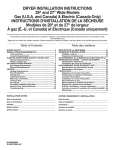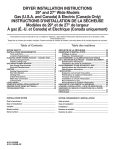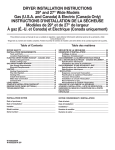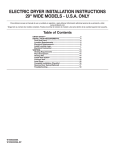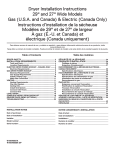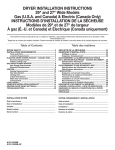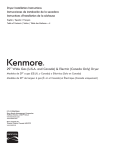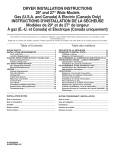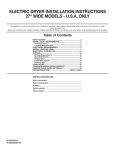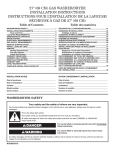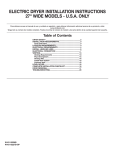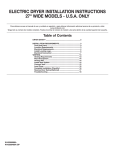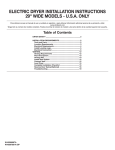Download Electric (Canada Only)
Transcript
DRYER INSTALLATION INSTRUCTIONS
29" and 27" Wide Models
Gas (U.S.A. and Canada) & Electric (Canada Only)
INSTRUCTIONS D’INSTALLATION DE LA SÉCHEUSE
Modèles de 29" et de 27" de largeur
À gaz (É.-U. et Canada) et Électrique (Canada uniquement)
Para obtener acceso al manual de uso y cuidado en español, o para obtener información adicional acerca de su producto, visite:
www.whirlpool.com
Tenga listo su número de modelo completo. Puede encontrar el número de modelo y de serie dentro de la cavidad superior de la puerta.
Table of Contents
Table des matières
DRYER SAFETY ................................................................ 2
INSTALLATION REQUIREMENTS .................................... 4
SÉCURITÉ DE LA SÉCHEUSE ....................................... 21
EXIGENCES D’INSTALLATION ...................................... 23
INSTALLATION NOTES
NOTES CONCERNANT L’INSTALLATION
Date of purchase: _________________________________
Date d’achat : _____________________________________
_______________________________
Installer: ________________________________________
Model number: ___________________________________
Serial number: ___________________________________
Date d’installation :
Tools and Parts .................................................................... 4
Location Requirements ...................................................... 5
ELECTRIC DRYER POWER HOOKUP-CANADA ONLY ........... 7
Electrical Requirements ..................................................... 7
Install Leveling Legs ........................................................... 7
GAS DRYER POWER HOOKUP ................................................. 8
Gas Supply Requirements .................................................. 8
Electrical Requirements ..................................................... 9
VENTING.................................................................................... 10
Venting Requirements....................................................... 10
Plan Vent System............................................................... 11
Venting Kits ........................................................................ 11
Install Vent System ............................................................ 12
Make Gas Connection ...................................................... 13
Connect Vent ..................................................................... 13
Level Dryer ......................................................................... 14
Complete Installation Checklist ....................................... 14
Reverse Door Swing (Optional) ........................................ 14
Troubleshooting................................................................. 20
Date of installation:
W10096984A
W10097000A-SP
Outillage et pièces ............................................................ 23
Exigences d’emplacement ............................................... 24
RACCORDEMENT À L’ALIMENTATION ÉLECTRIQUE DE LA
SÉCHEUSE ÉLECTRIQUE - CANADA SEULEMENT ............. 26
Spécifications électriques ................................................ 26
Installation des pieds de nivellement .............................. 27
RACCORDEMENT D’UNE SÉCHEUSE À GAZ ....................... 27
Spécifications de l’alimentation en gaz .......................... 27
Spécifications électriques ................................................ 29
L’ÉVACUATION.......................................................................... 30
Exigences concernant l’évacuation ................................ 30
Planification du système d’évacuation ........................... 31
Trousses d’évacuation ...................................................... 31
Installation du circuit d’évacuation ................................. 33
Raccordement au gaz ....................................................... 33
Raccordement du conduit d’évacuation ......................... 34
Réglage de l’aplomb de la sécheuse............................... 34
Achever l’installation - liste de vérification..................... 35
Inversion du sens de l’ouverture de la porte (facultatif) .. 35
Dépannage ......................................................................... 42
________________________________
Installateur : ______________________________________
Numéro de modèle : ________________________________
Numéro de série : __________________________________
1
DRYER SAFETY
Your safety and the safety of others are very important.
We have provided many important safety messages in this manual and on your appliance. Always read and obey all safety
messages.
This is the safety alert symbol.
This symbol alerts you to potential hazards that can kill or hurt you and others.
All safety messages will follow the safety alert symbol and either the word “DANGER” or “WARNING.”
These words mean:
DANGER
WARNING
You can be killed or seriously injured if you don't immediately
follow instructions.
You can be killed or seriously injured if you don't follow
instructions.
All safety messages will tell you what the potential hazard is, tell you how to reduce the chance of injury, and tell you what can
happen if the instructions are not followed.
IMPORTANT: The gas installation must conform with local codes, or in the absence of local codes, with the National Fuel Gas
Code, ANSI Z223.1/NFPA 54 or the Canadian Natural Gas and Propane Installation Code, CSA B149.1.
The dryer must be electrically grounded in accordance with local codes, or in the absence of local codes, with the National
Electrical Code, ANSI/NFPA 70 or Canadian Electrical Code, CSA C22.1.
2
WARNING: For your safety, the information in this manual must be followed to minimize
the risk of fire or explosion, or to prevent property damage, personal injury, or death.
– Do not store or use gasoline or other flammable vapors and liquids in the vicinity of this
or any other appliance.
– WHAT TO DO IF YOU SMELL GAS:
t Do not try to light any appliance.
t Do not touch any electrical switch; do not use any phone in your building.
t Clear the room, building, or area of all occupants.
t Immediately call your gas supplier from a neighbor's phone. Follow the gas supplier's
instructions.
t If you cannot reach your gas supplier, call the fire department.
– Installation and service must be performed by a qualified installer, service agency, or
the gas supplier.
WARNING: Gas leaks cannot always be detected by smell.
Gas suppliers recommend that you use a gas detector approved by UL or CSA.
For more information, contact your gas supplier.
If a gas leak is detected, follow the “What to do if you smell gas” instructions.
3
" $
$ $
!!$
#" #
IMPORTANT SAFETY INSTRUCTIONS
When discarding or storing your old clothes dryer, remove the door.
SAVE THESE INSTRUCTIONS
INSTALLATION REQUIREMENTS
Tools and Parts
Gather the required tools and parts before starting installation.
Tools needed for all installations:
Adjustable wrench that
opens to 1" (25 mm) or
hex-head socket wrench
Flat-blade screwdriver
Caulking gun and compound
(for installing new exhaust vent)
#2 Phillips screwdriver
Utility knife
Tools needed for gas installations:
1/4" nut driver or socket
wrench (recommended)
Tin snips (new vent
installations)
8" or 10" pipe wrench
Tape measure
Level
4
Vent clamps
Pliers
Pipe-joint compound
resistant to LP gas
8" or 10" adjustable wrench
(for gas connections)
Parts supplied:
Leveling legs (4)
Parts package is located in dryer drum. Check that all parts
are included.
Parts needed:
Check local codes. Check existing electrical supply and venting.
See “Electrical Requirements” and “Venting Requirements”
before purchasing parts.
Check code requirements. Some codes limit, or do not permit,
installing dryer in garages, closets, mobile homes, or sleeping
quarters. Contact your local building inspector.
Optional Equipment: (Not supplied with dryer)
If you are using power supply cord, a grounded electrical
outlet located within 2 ft. (610 mm) of either side of dryer.
See “Electrical Requirements.”
N A sturdy floor to support dryer and a total weight (dryer
and load) of 200 lbs. (90.7 kg). The combined weight of a
companion appliance should also be considered.
N Level floor with maximum slope of 1" (25 mm) under entire
dryer. If slope is greater than 1" (25 mm), install Extended
Dryer Feet Kit, Part Number 279810. If not level, clothes
may not tumble properly and automatic sensor cycles may
not operate correctly.
Do not operate your dryer at temperatures below 45°F (7°C). At
lower temperatures, the dryer might not shut off at the end of an
automatic cycle. Drying times can be extended.
N
The dryer must not be installed or stored in an area where it will
be exposed to water and/or weather.
Check code requirements. Some codes limit, or do not permit,
installation of the dryer in garages, closets, mobile homes, or
sleeping quarters. Contact your local building inspector.
NOTE: No other fuel-burning appliance can be installed in the
same closet as a dryer.
Refer to your Use and Care Guide for information about
accessories available for your dryer.
Location Requirements
You will need:
N A location allowing for proper exhaust installation.
See “Venting Requirements.”
N A separate 30 amp circuit for electric dryers.
N A separate 15 or 20 amp circuit for gas dryers.
5
Installation clearances:
The location must be large enough to allow the dryer door to open fully.
Most installations require a minimum 5½" (140 mm) clearance behind the dryer for the exhaust vent with elbow. See “Venting
Requirements.”
29" Wide Models
Dryer Dimensions
27" Wide Models
Dryer Dimensions
23¾"
(603 mm)
43"
(1092 mm)
43"
(1092 mm)
13¾"
(349 mm)
*29 1/2"
(749 mm)
27"
(687 mm)
A
*29 1/2"
(749 mm)
27"
(687 mm)
B
A. Large opening side-swing door
B. Wide opening hamper door
Installation Spacing
14" max.*
(356 mm)
18"*
(457 mm)
3"*
(76 mm)
2
48 in.*
2
(310 cm )
24 in.* 2
(155 cm )
2
A. Large opening side-swing door
B. Large opening side-swing door
C. Wide opening side-swing door
D. Wide opening hamper door
1"
(25 mm)
Installation Spacing
14" max.*
(356 mm)
18"*
(457 mm)
27"
(686 mm)
A
C
A. Recessed area
B. Side view - closet or confined area
C. Closet door with vents
3"*
(76 mm)
48 in.2*
2
(310 cm )
1"* 29 ¼" 5 ½"*
1"
(25 mm) (25 mm) (743 mm) (140 mm)
B
3"*
(76 mm)
*Required spacing
Installation spacing for recessed area or closet
The dimensions shown are for the minimum spacing allowed.
24 in.2 * 2
(155 cm )
1"
(25 mm)
29"
(737 mm)
A
1"* 27¾"
1"
(25 mm) (25 mm) (705 mm)
B
3"*
(76 mm)
N
N
C
N
A. Recessed area
B. Side view - closet or confined area
C. Closet door with vents
N
*Required spacing
N
Additional spacing should be considered for ease of
installation and servicing.
Additional clearances might be required for wall, door, and
floor moldings.
Additional spacing of 1" (25 mm) on all sides of the dryer is
recommended to reduce noise transfer.
For closet installation, with a door, minimum ventilation
openings in the top and bottom of the door are required.
Louvered doors with equivalent ventilation openings are
acceptable.
Companion appliance spacing should also be considered.
Mobile home - Additional installation requirements
This dryer is suitable for mobile home installations. The
installation must conform to the Manufactured Home
Construction and Safety Standard, Title 24 CFR, Part 3280
(formerly the Federal Standard for Mobile Home Construction and
Safety, Title 24, HUD Part 280) or the Canadian Manufactured
Home Standard CAN/CSA-Z240 MH.
6
N
N
Metal exhaust system hardware, available for purchase.
For further information, please reference the “Assistance or
Service” section of the “Dryer User Instructions.”
Special provisions must be made in mobile homes to
introduce outside air into the dryer. The opening (such as a
nearby window) should be at least twice as large as the dryer
exhaust opening.
ELECTRIC DRYER POWER
HOOKUP - CANADA ONLY
Electrical Requirements
WARNING
GROUNDING INSTRUCTIONS
"
"
!!
" "! "
!
WARNING:
Electrical Shock Hazard
Plug into a grounded 4 prong outlet.
Failure to do so can result in death or electrical shock.
! "!"
"" !
"! "
SAVE THESE INSTRUCTIONS
It is your responsibility:
N
N
N
N
To contact a qualified electrical installer.
To be sure that the electrical connection is adequate
and in conformance with the Canadian Electrical Code,
C22.1-latest edition and all local codes. A copy of the
above codes standard may be obtained from: Canadian
Standards Association, 178 Rexdale Blvd., Toronto, ON
M9W 1R3 CANADA.
To supply the required 4 wire, single phase, 120/240 volt,
60 Hz., AC only electrical supply on a separate 30-amp
circuit, fused on both sides of the line. A time-delay fuse or
circuit breaker is recommended. Connect to an individual
branch circuit.
This dryer is equipped with a CSA International Certified
Power Cord intended to be plugged into a standard 14-30R
wall receptacle. The cord is 5 ft. (1.52 m) in length. Be sure
wall receptacle is within reach of dryer’s final location.
Install Leveling Legs
WARNING
Excessive Weight Hazard
Use two or more people to move and install dryer.
Failure to do so can result in back or other injury.
1.
Prepare dryer for leveling legs
4-wire receptacle (14-30R)
N Do not use an extension cord.
If using a replacement power supply cord, it is recommended that
you use Power Supply Cord Replacement Part Number 8579325.
For further information, please reference the “Assistance or
Service” section of the “Dryer User Instructions.”
To avoid damaging floor, use a large flat piece of cardboard
from dryer carton; place under entire back edge of dryer.
Firmly grasp dryer body (not console panel) and gently lay
dryer down on cardboard.
7
2.
Gas type
Screw in leveling legs
diamond
marking
Natural gas:
This dryer is equipped for use with Natural Gas. It is designcertified by CSA International for LP (propane or butane) gases
with appropriate conversion.
N
Your dryer must have the correct burner for the type of gas
in your home. Burner information is located on the rating
plate in the door well of your dryer. If this information does
not agree with the type of gas available, please reference
the “Assistance or Service” section of the “Dryer User
Instructions.”
LP gas conversion:
Examine leveling legs, find diamond marking. Screw legs into
leg holes by hand, use a wrench to finish turning legs until
diamond marking is no longer visible.
Now stand the dryer on its feet. Slide the dryer until it is
close to its final location. Leave enough room to connect the
exhaust vent.
For mobile home use
Gas dryers must be securely fastened to the floor.
Conversion must be made by a qualified technician.
No attempt shall be made to convert the dryer from the gas
specified on the model/serial rating plate for use with a different
gas without consulting the serving gas supplier.
IMPORTANT: The gas installation must conform with local codes,
or in the absence of local codes, with the National Fuel Gas
Code, ANSI Z223.1/NFPA 54 or the Canadian Natural Gas and
Propane Installation Code, CSA B149.1.
Gas supply line
N
N
N
Mobile home installations require a Mobile Home Installation
Hold-down Kit. For ordering information please reference the
“Dryer User Instructions.”
GAS DRYER POWER
HOOKUP
Gas Supply Requirements
WARNING
N
1/2" NPT pipe is recommended.
3/8" approved tubing is acceptable for lengths under
20 ft. (6.1 m) if local codes and gas supplier permit.
Must include 1/8" NPT minimum plugged tapping accessible
for test gauge connection, immediately upstream of the gas
connection to the dryer (see illustration).
Must include a shutoff valve:
In the U.S.A.:
An individual manual shutoff valve must be installed within
six (6) feet (1.8 m) of the dryer in accordance with the
National Fuel Gas Code, ANSI Z223.1.
In Canada:
An individual manual shutoff valve must be installed in
accordance with the B149.1, Natural Gas and Propane
Installation Code. It is recommended that an individual
manual shutoff valve be installed within six (6) feet (1.8 m)
of the dryer.
The shut off valve location should be easy to reach for opening
and closing.
C
+#"&"!-%
A
&!*!'%!'"!##%")&&(##,!
!&'&('"))
(%,''!&"!!'"!&
"!!''")$(.#%&"! &(%
&#%&&(%"&!"'+
*'%
"( !
+ #&"$(.#%&"!!(
!&'!#%&"!!
('"%-&" #!,#%&"!!!
('"%-&%)#%&"!!
(%'""&"!%&('!'+#"&"!"%.%
8
E
D
B
A. 3/8" flexible gas connector
B. 3/8" pipe to flare adapter fitting
C. 1/8" NPT minimum plugged tapping
D. 1/2" NPT gas supply line
E. Gas shutoff valve
Gas supply connection requirements
There are many methods by which your gas dryer can be
connected to the gas supply. Listed here are some guidelines
for two different methods of connection.
Option 1 (Recommended Method)
Flexible stainless steel gas connector:
N
If local codes permit, use a new flexible stainless steel gas
connector (Design Certified by the American Gas Association
or CSA International) to connect your dryer to the rigid gas
supply line. Use an elbow and a 3/8" flare x 3/8" NPT adapter
fitting between the stainless steel gas connector and the
dryer gas pipe, as needed to prevent kinking.
Option 2 (Alternate Method)
Approved aluminum or copper tubing:
N
N
N
N
N
N
Elevations above 10,000 ft. (3,048 m):
N When installed above 10,000 ft. (3,048 m) a 4% reduction
of the burner B.T.U. rating shown on the model/serial
number plate is required for each 1,000 ft. (305 m)
increase in elevation.
Gas supply pressure testing
N The dryer must be disconnected from the gas supply piping
system during pressure testing at pressures greater than
1/2 psi.
Electrical Requirements
Lengths over 20 ft. (6.1 m) can use 3/8" approved tubing
(if codes and gas supplier permit).
If you are using Natural Gas, do not use copper tubing.
3/8" flare x 3/8" NPT adapter fitting between dryer pipe and
3/8" approved tubing.
Lengths over 20 ft. (6.1 m) should use larger tubing and a
different size adapter fitting.
If your dryer has been converted to use LP gas, 3/8" LP
compatible copper tubing can be used. If the total length
of the supply line is more than 20 ft. (6.1 m), use larger pipe.
WARNING
NOTE: Pipe joint compounds that resist the action of LP
gas must be used. Do not use TEFLON®† tape.
Dryer gas pipe
The gas pipe that comes out through the rear of your dryer
has a 3/8" male pipe thread.
!
29" Wide Model
N
1¼"
(32 mm)
120 Volt, 60 Hz., AC only, 15- or 20-amp fused electrical
supply is required. A time-delay fuse or circuit breaker is
recommended. It is also recommended that a separate circuit
serving only this dryer be provided.
GROUNDING INSTRUCTIONS
A
9¼"
(235 mm)
A. 3/8" NPT dryer pipe
27" Wide Model
A
*5 3/4"
(159 mm)
"
"
!!
" "! "
!
WARNING:
1 1/2"
(38 mm)
A. 3/8" NPT dryer pipe
! "!"
"" !
"! "
SAVE THESE INSTRUCTIONS
Burner input requirements
Elevations up to 10,000 ft. (3,048 m):
N The design of this dryer is certified by CSA International for
use at altitudes up to 10,000 ft. (3,048 m), above sea level at
the B.T.U. rating indicated on the model/serial number plate.
Burner input adjustments are not required when the dryer is
operated up to this elevation.
†®TEFLON is a registered trademark of E.I. Du Pont De Nemours and Company.
9
VENTING
Venting Requirements
Exhaust hoods:
N
WARNING
Must be at least 12" (305 mm) from ground or any object
that may obstruct exhaust (such as flowers, rocks, bushes,
or snow).
B
4"
(102 mm)
A
Fire Hazard
4"
(102 mm)
Use a heavy metal vent.
Recommended styles:
A. Louvered hood
B. Box hood
Do not use a metal foil vent.
WARNING: To reduce the risk of fire, this dryer MUST BE
2½"
(64 mm)
4"
(102 mm)
Do not use a plastic vent.
Failure to follow these instructions can result in death
or fire.
C
Acceptable styles:
C. Angled hood
Elbows:
N
45° elbows provide better airflow than 90° elbows.
EXHAUSTED OUTDOORS.
IMPORTANT: Observe all governing codes and ordinances.
Dryer exhaust must not be connected into any gas vent,
chimney, wall, ceiling, attic, crawlspace, or a concealed space
of a building. Only rigid or flexible metal vent shall be used for
exhausting.
N
N
Only a 4" (102 mm) heavy metal exhaust
vent and clamps may be used.
Do not use plastic or metal foil vent.
Good
Better
Clamps:
Rigid metal vent:
N
Recommended for best drying performance and to avoid
crushing and kinking.
Flexible metal vent: (Acceptable only if accessible to clean)
Must be fully extended and supported in final dryer location.
Remove excess to avoid sagging and kinking that may result
in reduced airflow and poor performance.
N Do not install in enclosed walls, ceilings, or floors.
N The total length should not exceed 7 3/4 ft. (2.4 m).
NOTE: If using an existing vent system, clean lint from entire
length of the system and make sure exhaust hood is not plugged
with lint. Replace plastic or metal foil vents with rigid metal or
flexible metal vents. Review Vent system chart and if necessary,
modify existing vent system to achieve best drying performance.
N
N
Use clamps to seal all joints.
Exhaust vent must not be connected or secured with screws
or other fastening devices that extend into interior of duct
and catch lint. Do not use duct tape.
N
N
Improper venting can cause moisture and lint to collect
indoors, which may result in:
Moisture damage to woodwork, furniture, paint, wallpaper,
carpets, etc.
Housecleaning problems and health problems.
See “Venting Kits” for more information.
10
Alternate installations for close clearances
Plan Vent System
Venting systems come in many varieties. Select the type best
for your installation. Two close-clearance installations are shown.
Refer to the manufacturer’s instructions.
Recommended exhaust installations
Typical installations vent the dryer from the rear of the dryer.
Other installations are possible.
B
C
D
E
A
F
G
Over-The-Top installation (also available with one offset elbow)
B
I
A. Dryer
B. Elbow
C. Wall
D. Exhaust hood
E. Clamps
H
F. Rigid metal or flexible metal vent
G. Vent length necessary to connect elbows
H. Exhaust outlet
I. Optional side exhaust outlet
Optional exhaust installations:
27" Wide Models can be converted to exhaust out the right side,
left side, or through the bottom (4-way vent kit). Each kit includes
step-by-step instructions. For ordering information, see “Venting
Kits”.
Periscope installation
NOTE: The following kits for close clearance alternate
installations are available for purchase.
Venting Kits
For more information, call 1-800-901-2042, or visit us at
www.applianceaccessories.com. In Canada, call
1-800-807-6777 or visit us at www.whirlpoolparts.ca.
Part Number Descriptions
A
B
C
A. Standard rear offset exhaust installation
B. Left or right side exhaust installation
(27" wide models only)
C. Bottom exhaust installation (27" wide models only)
8171587RP
0–5" Metal vent periscope
4396037RP
0"-18" Metal vent periscope
4396011RP
18" - 29" Metal vent periscope
4396014
29" - 50" Metal vent periscope
4392892
In-Wall metal DuraVent™ Periscope
279818
4-way vent kit - white (27" Dryers Only)
W10186596
4-way vent kit - universal grey (27" Dryers Only)
4396028
Sure Connect™ venting kit
(over-the-top installation)
4396009RP
5' Universal connect vent, flexible dryer venting
4396010RP
6' SecureConnect™ vent, flexible dryer venting
4396013RB
Dryer vent installer’s kit
4396033RP
5' flexible dryer venting with clamps
4396727RP
8' flexible dryer venting with clamps
4396004
Dryer offset elbow
4396005
Wall offset elbow
4396006RW
DuraSafe™ close elbow
4396007RW
Through-the-wall vent cap
4396008RP
4" steel dryer venting clamps - 2 pack
8212662
Flush mounting louvered vent hood 4"
11
Special provisions for mobile home installations:
The exhaust vent must be securely fastened to a noncombustible
portion of the mobile home structure and must not terminate
beneath the mobile home. Terminate the exhaust vent outside.
Determine vent path:
N
N
N
N
N
Select route that will provide straightest and most direct path
outdoors.
Plan installation to use fewest number of elbows and turns.
When using elbows or making turns, allow as much room
as possible.
Bend vent gradually to avoid kinking.
Use as few 90° turns as possible.
Determine vent length and elbows needed for best
drying performance:
N
Use following Vent system chart to determine type of vent
material and hood combinations acceptable to use.
NOTE: Do not use vent runs longer than those specified
in Vent system chart. Exhaust systems longer than those
specified will:
N Shorten life of dryer.
N Reduce performance, resulting in longer drying times and
increased energy usage.
The Vent system chart provides venting requirements that will
help achieve best drying performance.
Vent System Chart
Number of
90° turns or
elbows
Type
of vent
Box/louvered
hoods
Angled
hoods
0
Rigid metal
64 ft. (20 m)
58 ft. (17.7 m)
1
Rigid metal
54 ft. (16.5 m)
48 ft. (14.6 m)
2
Rigid metal
44 ft. (13.4 m)
38 ft. (11.6 m)
3
Rigid metal
35 ft. (10.7 m)
29 ft. (8.8 m)
4
Rigid metal
27 ft. (8.2 m)
21 ft. (6.4 m)
NOTE: Side and bottom exhaust installations for 27" wide
models have a 90º turn inside the dryer. To determine
maximum exhaust length, add one 90º turn to the chart.
Vent System Chart
(29" Wide Long Vent Models Only)
Box/louvered, or
Angled hoods
Number of
90° turns
or elbows
Type
of vent
0
Rigid metal
120 ft. (36.6 m)
1
Rigid metal
110 ft. (33.5 m)
2
Rigid metal
100 ft. (30.5 m)
3
Rigid metal
90 ft. (27.4 m)
4
Rigid metal
80 ft. (24.4 m)
5
Rigid metal
70 ft. (21.3 m)
Install Vent System
1. Install exhaust hood
12" min.
(305 mm)
12" min.
(305 mm)
Install exhaust hood and use caulking compound to seal
exterior wall opening around exhaust hood.
12
2. Connect vent to exhaust hood
3. Open shut-off valve
Closed valve
Open valve
Vent must fit over the exhaust hood. Secure vent to exhaust
hood with 4" (102 mm) clamp. Run vent to dryer location
using straightest path possible. Avoid 90° turns. Use clamps
to seal all joints. Do not use duct tape, screws, or other
fastening devices that extend into interior of vent to secure
vent, because they can catch lint.
Open shut-off valve in supply line; valve is open when handle
is parallel to gas pipe. Then, test all connections by brushing
on an approved noncorrosive leak-detection solution.
Bubbles will show a leak. Correct any leaks found.
Connect Vent
1. Connect vent to exhaust outlet
Make Gas Connection
1. Connect gas supply to dryer
Flared
male fitting
Non-flared
male fitting
Using a 4" (102 mm) clamp, connect vent to exhaust outlet
in dryer. If connecting to existing vent, make sure vent is
clean. Dryer vent must fit over dryer exhaust outlet and inside
exhaust hood. Check that vent is secured to exhaust hood
with a 4" (102 mm) clamp.
Remove red cap from gas pipe. Using a wrench to tighten,
connect gas supply to dryer. Use pipe-joint compound
on threads of all non-flared male fittings. If flexible metal
tubing is used, be sure there are no kinks.
NOTE: For LP gas connections, you must use pipe-joint
compound resistant to action of LP gas. Do not use
TEFLON®† tape.
2. Move dryer to final location
2. Plan pipe fitting connection
D
A
C
B
A. 3/8" flexible gas connector
B. 3/8" dryer pipe
C. 3/8" to 3/8" pipe elbow
D. 3/8" pipe-to-flare adapter fitting
A combination of pipe fittings must be used to connect dryer
to existing gas line. A recommended connection is shown.
Your connection may be different, according to supply line
type, size, and location.
Move dryer to final location. Avoid crushing or kinking vent.
After dryer is in place, remove corner posts and cardboard
from under the dryer.
†®TEFLON is a registered trademark of E.I. Dupont De Nemours and Company.
13
Level Dryer
1.
Level dryer
Q
Q
Remove film on console and any tape remaining on dryer.
Q
Q
Read “Dryer Use” in your Use and Care Guide.
Wipe dryer drum interior thoroughly with a damp cloth to
remove any dust.
Set the dryer on a full heat cycle (not an air cycle) for
20 minutes and start the dryer.
If the dryer will not start, check the following:
N Dryer is plugged into a grounded 3 prong outlet.
N Electrical supply is connected.
N Household fuse is intact and tight, or circuit breaker has
not tripped.
N Dryer door is closed.
Q
Check levelness of dryer from side to side. Repeat from
front to back.
NOTE: The dryer must be level for the moisture sensing system
to operate correctly.
When the dryer has been running for 5 minutes, open the
dryer door and feel for heat. If you feel heat, cancel cycle and
close the door.
If you do not feel heat, turn the dryer off and check to see
whether gas supply line shutoff valve is open.
N If the gas supply line shutoff valve is closed, open it,
then repeat the 5-minute test as outlined above.
N If the gas supply line shutoff valve is open, contact a
qualified technician.
NOTE: You may notice an odor when the dryer is first heated.
This odor is common when the heating element is first used. The
odor will go away.
Not Level
LEVEL
Not Level
2. Tighten and adjust leveling legs
Reverse Door Swing (Optional)
If your door is the 29" Large Side-Swing Door,
follow steps 1-6.
If your door is the 29" Super Wide Side-Swing Door,
follow steps 1-13.
If dryer is not level, prop up using a wood block, use wrench
to adjust legs up or down, and check again for levelness.
Once legs are level, make sure all four legs are snug against
the ground before tightening them.
Complete Installation Checklist
Q
Check that all parts are now installed. If there is an extra
part, go back through steps to see what was skipped.
Q
Q
Q
Check that you have all of your tools.
Q
14
If your door is the 27" Wide Side-Swing Door,
follow steps 1-11.
Dispose of/recycle all packaging materials.
Check dryer’s final location. Be sure vent is not crushed
or kinked.
Check that dryer is level. See “Level Dryer”.
NOTE: Magnetized screw driver is helpful.
29" Wide Model Large Side-Swing Door
1. Place towel on dryer
Place towel on top of dryer to avoid damaging the surface.
2. Remove bottom screws
4. Remove and transfer hinge
hole plugs
Us a small,
Use
all, flat-blade screwdriver
driv tto gently
ntly remove 4 hi
hinge
hole plugs on left side of dryer cabinet. Insert plugs into hinge
holes on opposite side of dryer cabinet.
5. Insert screws in hinge holes on
dryer cabinet
Open dryer door. Remove bottom screws from dryer cabinet
side of hinges. Loosen (do not remove) top screws from dryer
cabinet side of hinges.
3. Lift door off top screws
NOTE: Two people maybe needed to reinstall door.
Insert screws into bottom holes on left side of dryer cabinet.
Tighten screws halfway. Position door so large end of door
hinge slot is over screws. Slide door up so screws are in
bottom of slots. Tighten screws. Insert and tighten top
screws in hinges.
6. Check door strike alignment
Lift door
d
til to
bi t are in llarge partt of hin
until
top screws iin cabinet
hinge
slot. Pull door forward off screws. Set door on top of dryer.
Remove top screws from dryer cabinet.
Close door and check that door strike aligns with door
catch. If needed, slide door catch left or right within slot
to adjust alignment.
15
29" Super Wide Side-Swing Door
4. Remove screws from hinges
1. Place towel on dryer
Remove screws attaching hinges to door.
Place towel on top of dryer to avoid damaging the surface.
5. Remove screws from door
2. Remove bottom screws
Open dryer door. Remove bottom screws from dryer cabinet
side of hinges. Loosen (do not remove) top screws from
dryer cabinet side of hinges.
3. Lift door off top screws
Remove screws at top,
top bottom
bottom, and side of door
(4 screws). Keep door screws separate from hinge screws
as they are diferent sizes. Holding door over towel on dryer,
grasp sides of outer door and lift to separate it from inner
door.
NOTE: Do not pry apart with putty knife or screwdriver.
Do not pull on door seal or plastic door catches.
6. Rotate outer door
Take outer door and rotate in 180º and set it back down on
inner door. Be certain to keep cardboard spacer centered
between doors. Reattach outer door panel to inner door
panel so handle is on the side where hinges were just
removed. Insert 4 door screws.
Lift door until top screws in dryer cabinet are in large part of
hinge slot. Pull door forward off screws. Set door (handle side
up) on top of dryer. Remove top screws from dryer cabinet.
16
7.
Flip door over
9.
Remove door strike
Flip door over so handle side is down.
8.
Attach door hinges
Remove door strike from dryer cabinet and set aside.
10. Remove and transfer
hinge hole plugs
Use a small, flat-blade screwdriver to gently remove 4 hinge
hole plugs on left side of dryer cabinet. Transfer plugs into
hinge holes on opposite side of dryer cabinet.
11. Insert screws in hinge holes on
dryer cabinet
Reattach door hinges to dryer door so that the larger hole is
at the bottom of the hinge.
NOTE: Two people maybe needed to reinstall door.
Insert screws into the bottom holes on left side of dryer
cabinet. Tighten screws halfway. Position door so large end
of door hinge slot is over screws. Slide door up so screws
are in bottom of slots. Tighten screws. Insert and tighten top
screws in hinges.
17
12. Remove door strike plug
Remove door strike plug. Insert the door strike removed in
Step 9 into hole and secure with screw. Insert door strike
plug into original door strike hole and secure with screw.
13. Check door strike alignment
Close door and check that door strike aligns with door
catch. If it is needed, slide door catch left or right within slot
to adjust alignment.
27" Wide Model Side-Swing Door
1.
2.
Remove bottom screws
Open dryer door. Remove bottom screws from dryer cabinet
side of hinges. Loosen (do not remove) top screws from dryer
cabinet side of hinges.
3.
Lift door off top screws
Lift door until top screws in dryer cabinet are in large part of
hinge slot. Pull door forward off screws. Set door (handle side
up) on top of dryer. Remove top screws from dryer cabinet.
4.
Remove screws from hinges
Place towel on dryer
Remove screws attaching hinges to door.
Place towel on top of dryer to avoid damaging the surface.
18
5.
Remove screws from door
8.
Attach door hinges
Remove screws at top, bottom, and side of door
(5 screws). Keep door screws separate from hinge screws
as they are different sizes. Holding door over towel on
dryer, grasp sides of outer door and lift to separate it from
inner door.
NOTE: Do not pry apart with putty knife or screwdriver.
Do not pull on door seal or plastic door catches.
6.
Rotate outer door
Reattach door hinges to dryer door so that the larger hole is
at the bottom of the hinge.
Take outer door and rotate it 180º and set it back down on
inner door. Be certain to keep cardboard spacer centered
between doors. Reattach outer door panel to inner door
panel so handle is on the side where hinges were just
removed. Insert 5 door screws.
7.
9.
Remove and transfer plugs
Flip door over
Remove the 4 screws that attach 2 plugs on the left side.
Transfer plugs to opposite side using the same 4 screws.
Flip door over so handle side is down.
19
10. Insert screws in hinge holes on
11. Check door strike alignment
dryer cabinet
NOTE: 2 people maybe needed to reinstall door.
Insert screws into the bottom holes on left side of dryer
cabinet. Tighten screws halfway. Position door so large end of
door hinge slot is over screws. Slide door up so screws are in
bottom of slots. Tighten screws. Insert and tighten top screws
in hinges.
20
Close door and check that door strike aligns with door
catch. If it is needed, slide door catch left or right
within slot to adjust alignment.
Troubleshooting
See the Use and Care Guide or visit our website and
reference Frequently Asked Questions to possibly avoid the
cost of a service call.




















